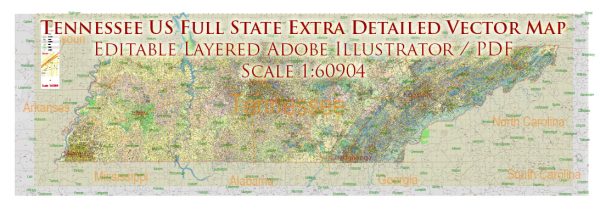Tennessee’s urban development is a fascinating journey that reflects the state’s rich history, economic evolution, and cultural diversity. The story of urban development in Tennessee encompasses various phases, from its early settlement to the present day.
- Early Settlement and Frontier Towns (Late 18th to Early 19th Century): Tennessee was initially settled by Native American tribes, and European pioneers began to arrive in the late 18th century. The establishment of forts and trading posts, such as Fort Loudoun and Fort Nashborough (which later became Nashville), marked the early stages of urban development. These settlements were essential for trade, defense, and community building.
- Antebellum Period and Cotton Economy (Early to Mid-19th Century): The 19th century saw the rise of agriculture, particularly cotton cultivation, in Tennessee. Cities like Memphis and Nashville grew as transportation hubs, with the Mississippi River and railroads playing crucial roles in connecting Tennessee to regional and national markets. The economic prosperity fueled by cotton led to the expansion of urban areas, and architecture from this period is still visible in historic districts.
- Civil War and Reconstruction (Mid-19th Century): The Civil War had a significant impact on Tennessee, as it was a border state with divided loyalties. Cities like Nashville and Chattanooga played strategic roles during the conflict. Following the war, Reconstruction brought about social and economic changes, and urban centers became focal points for rebuilding efforts.
- Industrialization and Economic Diversification (Late 19th to Early 20th Century): The late 19th century marked the beginning of industrialization in Tennessee. Cities like Knoxville and Chattanooga became centers for manufacturing, including textiles and iron production. The arrival of the railroad further facilitated economic growth and urbanization.
- Great Depression and New Deal Era (Early to Mid-20th Century): The Great Depression hit Tennessee hard, but the New Deal initiatives brought relief and contributed to the development of public infrastructure. Projects like the Tennessee Valley Authority (TVA) had a lasting impact on the state’s urban and rural areas by providing electricity and promoting regional development.
- Post-World War II Suburbanization (Mid-20th Century): Like many other parts of the United States, Tennessee experienced suburbanization after World War II. The automobile and the interstate highway system played a crucial role in the decentralization of population and economic activities. Cities adapted to changing patterns of living, leading to the growth of suburban communities.
- Contemporary Urban Challenges and Revitalization (Late 20th Century to Present): In recent decades, Tennessee’s cities have faced challenges such as urban decay, economic restructuring, and issues related to infrastructure and transportation. However, there has been a concerted effort to revitalize downtown areas, preserve historic districts, and attract businesses and residents back to urban cores.
Today, Tennessee’s cities reflect a dynamic blend of history and modernity, with each urban center contributing uniquely to the state’s cultural, economic, and social tapestry.


 Author: Kirill Shrayber, Ph.D.
Author: Kirill Shrayber, Ph.D.